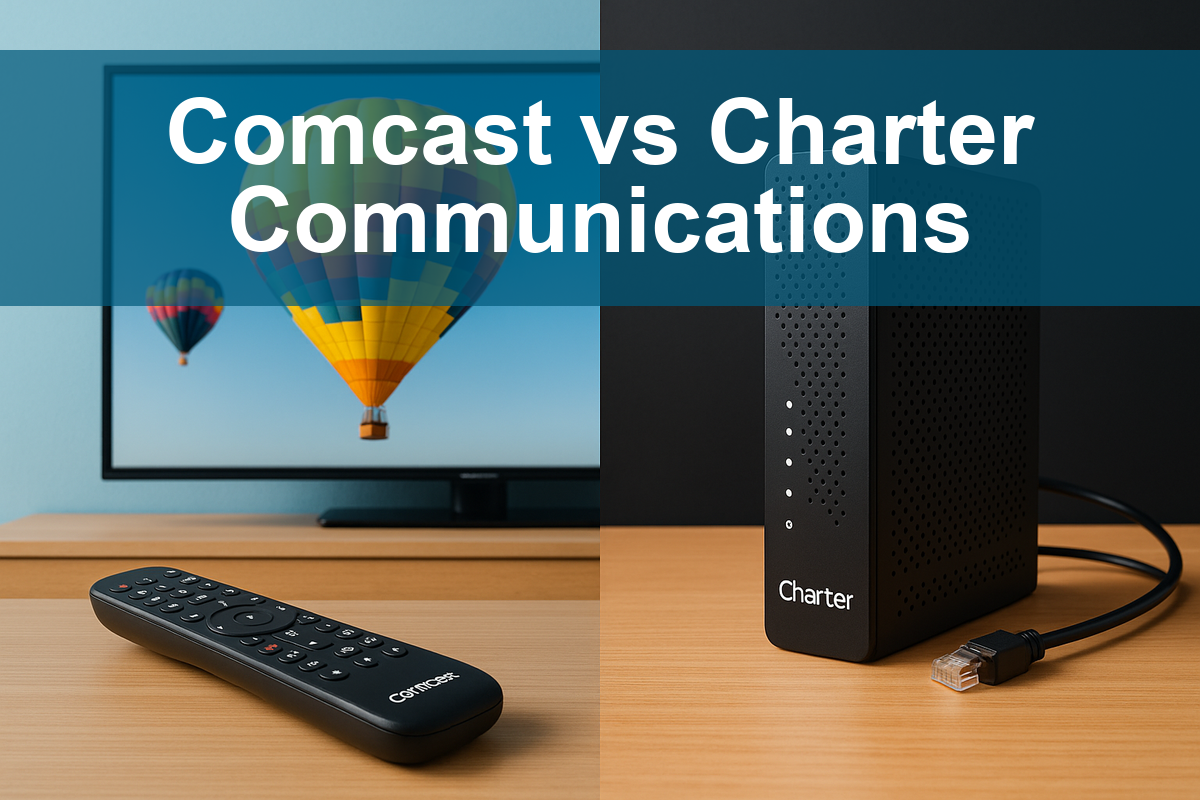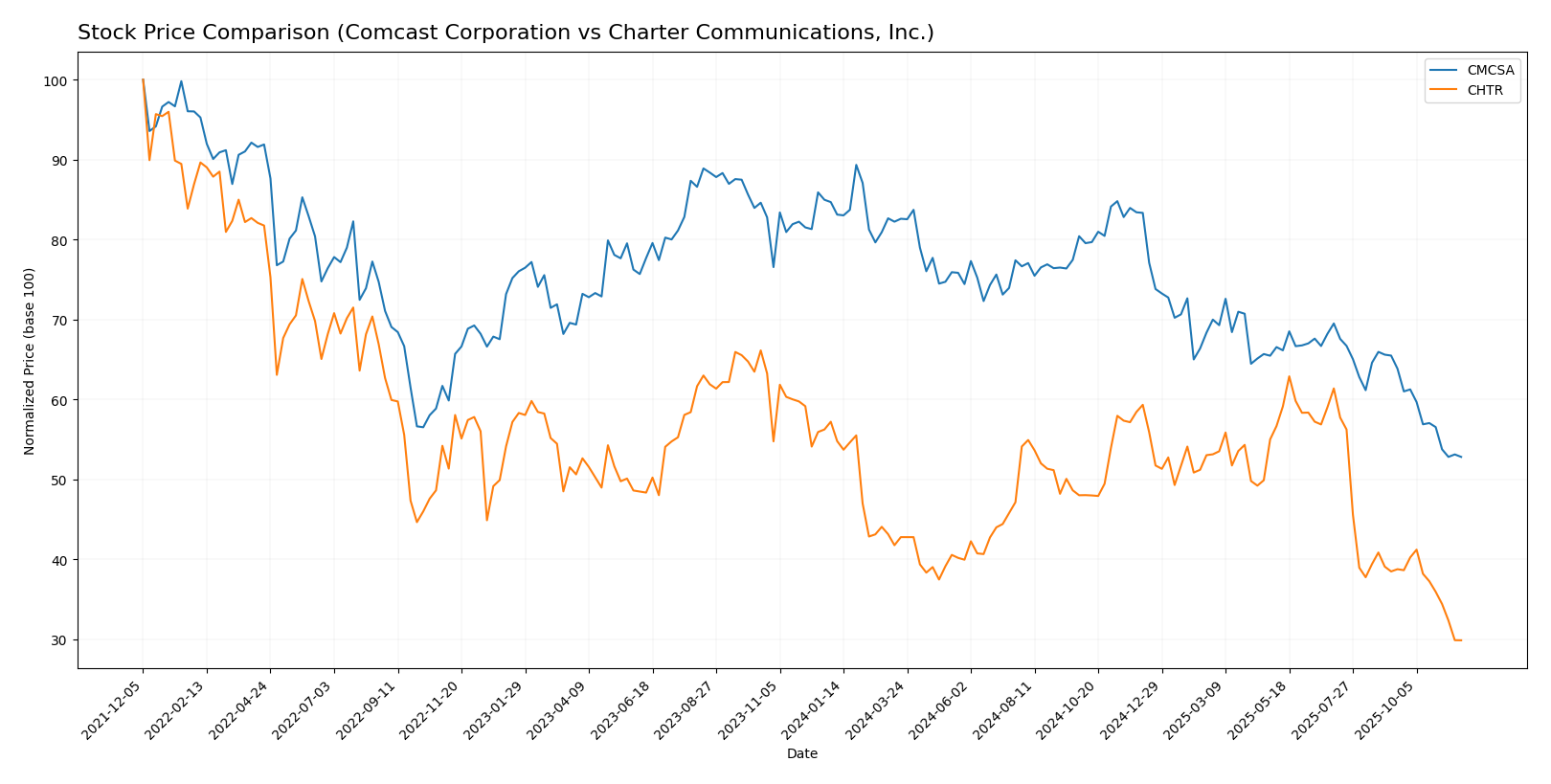In the competitive landscape of telecommunications, Comcast Corporation (CMCSA) and Charter Communications, Inc. (CHTR) stand out as key players, both vying for market dominance. As two giants in the industry, they share a common goal of providing innovative broadband and cable services. While Comcast leverages its diverse media segments and extensive customer base, Charter focuses on enhancing connectivity and customer experience. In this analysis, I will explore which of these companies presents a more compelling investment opportunity.

Table of contents
Company Overview
Comcast Corporation Overview
Comcast Corporation (CMCSA) is a leading media and technology company headquartered in Philadelphia, Pennsylvania. Founded in 1963, Comcast operates through various segments, including Cable Communications, Media, Studios, Theme Parks, and Sky. The company provides a broad array of services, such as broadband, video, voice, and wireless under its Xfinity brand. Its media segment includes NBCUniversal’s television networks and streaming platforms, while the Studios segment is responsible for film and television production. Additionally, Comcast runs theme parks globally, including Universal Studios. With a market capitalization of approximately $97.3B, Comcast serves millions of customers and continues to expand its footprint in the digital landscape.
Charter Communications, Inc. Overview
Charter Communications, Inc. (CHTR), founded in 1993 and headquartered in Stamford, Connecticut, operates as a prominent broadband connectivity and cable operator in the U.S. The company provides subscription-based video services, high-speed internet, and voice communications using Voice over Internet Protocol technology. Charter serves around 32 million customers across 41 states, showcasing its robust presence in the telecommunications sector. With a market cap of about $27.8B, Charter’s commitment to enhancing customer experience is evident through its innovative offerings, including Spectrum WiFi services and regional advertising solutions.
Key similarities and differences
Both Comcast and Charter operate in the telecommunications services sector, focusing on broadband and video offerings. However, Comcast has a more diversified portfolio, including theme parks and media production, while Charter emphasizes its broadband and cable services with a stronger focus on residential and commercial customers. This distinction highlights their varied approaches within the same industry.
Income Statement Comparison
Below is a comparison of the most recent income statements for Comcast Corporation (CMCSA) and Charter Communications, Inc. (CHTR). This analysis highlights key financial metrics that investors should consider.
| Metric | Comcast Corporation (CMCSA) | Charter Communications, Inc. (CHTR) |
|---|---|---|
| Market Cap | 97.26B | 27.80B |
| Revenue | 123.73B | 55.09B |
| EBITDA | 37.61B | 21.40B |
| EBIT | 22.81B | 12.73B |
| Net Income | 16.19B | 5.08B |
| EPS | 4.17 | 35.53 |
| Fiscal Year | 2024 | 2024 |
Interpretation of Income Statement
In reviewing the income statements for both companies, Comcast has shown a notable increase in revenue from 121.57B in 2023 to 123.73B in 2024, reflecting a growth trend. In contrast, Charter’s revenue growth has been more stable, moving from 54.61B in 2023 to 55.09B in 2024. Net income for Comcast rose to 16.19B, indicating a strong operational performance, while Charter’s net income experienced slight fluctuations. Despite the increase in both companies’ revenues, the margins reveal that Comcast maintains a stronger profitability profile, underscoring its competitive position in the telecommunications sector.
Financial Ratios Comparison
The table below provides a comparative analysis of the recent financial metrics for Comcast Corporation (CMCSA) and Charter Communications, Inc. (CHTR), allowing us to evaluate their operational efficiency, profitability, and financial health.
| Metric | CMCSA | CHTR |
|---|---|---|
| ROE | 18.92% | 32.61% |
| ROIC | 8.56% | 7.43% |
| P/E | 9.06 | 12.73 |
| P/B | 1.71 | 5.23 |
| Current Ratio | 0.68 | 0.31 |
| Quick Ratio | 0.68 | 0.31 |
| D/E | 1.16 | 8.86 |
| Debt-to-Assets | 37.22% | 66.72% |
| Interest Coverage | 5.64 | 2.41 |
| Asset Turnover | 0.46 | 0.37 |
| Fixed Asset Turnover | 1.98 | 1.28 |
| Payout Ratio | 29.73% | 0.00% |
| Dividend Yield | 3.28% | 0.00% |
Interpretation of Financial Ratios
CMCSA exhibits a strong return on equity (ROE) of 18.92%, indicating effective management of equity. In contrast, CHTR presents a higher ROE at 32.61%, showcasing superior profitability but with a significantly higher debt-to-equity ratio of 8.86, which raises concerns about financial leverage and risk. CMCSA’s stronger current and quick ratios suggest better liquidity. Overall, while CHTR shows impressive profitability, its high debt levels warrant caution for potential investors.
Dividend and Shareholder Returns
Comcast Corporation (CMCSA) has a dividend payout ratio of approximately 30%, with a dividend yield of 3.3%. This reflects a steady commitment to returning value to shareholders, supported by consistent free cash flow. In contrast, Charter Communications, Inc. (CHTR) does not pay dividends, opting instead to reinvest profits for growth, which may align with their long-term strategy but limits immediate shareholder returns. Both companies engage in share buybacks, which could enhance shareholder value over time. Overall, CMCSA’s approach appears to support sustainable value creation, while CHTR’s strategy hinges on future growth potential.
Strategic Positioning
In the telecommunications services market, Comcast Corporation (CMCSA) holds a significant market share, leveraging its diverse offerings in broadband, media, and entertainment. It competes closely with Charter Communications, Inc. (CHTR), which has carved out its niche in broadband and cable services. Both companies face competitive pressure from emerging technologies and player disruptions, necessitating ongoing innovation to maintain their market positions. As of now, CMCSA is valued at approximately $97.3B, while CHTR’s market cap stands at $27.8B, reflecting their differing scales in the industry.
Stock Comparison
In this section, I will analyze the weekly stock price movements of Comcast Corporation (CMCSA) and Charter Communications, Inc. (CHTR) over the past year, highlighting key trading dynamics and price changes.

Trend Analysis
Comcast Corporation (CMCSA) has experienced a significant price change of -37.99% over the past year. This indicates a bearish trend, with prices having decelerated recently. The stock reached a high of 46.26 and a low of 26.69. The standard deviation of 4.44 suggests some volatility in its trading patterns.
In the recent analysis period from September 14, 2025, to November 30, 2025, CMCSA’s price declined by -19.27%, with a standard deviation of 1.99, indicating reduced volatility. The trend slope is negative at -0.56, reinforcing the ongoing bearish sentiment.
Charter Communications, Inc. (CHTR) has seen an even steeper price change of -46.23% over the past year, also reflecting a bearish trend. The stock hit a high of 427.25 and a low of 200.12, with a notable standard deviation of 54.04, indicating heightened volatility.
From September 14, 2025, to November 30, 2025, CHTR’s price fell by -24.02%, with a higher standard deviation of 27.52, suggesting some fluctuations in investor sentiment. The trend slope of -7.38 confirms a continuous downward trajectory.
In summary, both stocks are currently in a bearish trend, with substantial declines over the past year and during the recent analysis period. Investors should exercise caution given the notable volatility indicated by the standard deviations.
Analyst Opinions
Recent analyst recommendations for Comcast Corporation (CMCSA) and Charter Communications, Inc. (CHTR) indicate strong confidence in both companies. CMCSA received an “A” rating, with analysts highlighting excellent discounted cash flow and return on equity scores. Charter Communications follows closely with an “A-” rating, praised for its solid cash flow and return on equity, though it has a lower debt-to-equity score. Overall, the consensus for both stocks is a “buy,” reflecting positive sentiment in the current market.
Stock Grades
In the current market landscape, I’ve gathered recent stock ratings from credible grading companies for two notable firms in the telecommunications sector: Comcast Corporation (CMCSA) and Charter Communications, Inc. (CHTR).
Comcast Corporation Grades
| Grading Company | Action | New Grade | Date |
|---|---|---|---|
| Citigroup | maintain | Buy | 2025-11-03 |
| Barclays | maintain | Equal Weight | 2025-11-03 |
| Goldman Sachs | maintain | Neutral | 2025-11-03 |
| Bernstein | maintain | Market Perform | 2025-10-31 |
| Scotiabank | maintain | Sector Perform | 2025-10-31 |
| Evercore ISI Group | maintain | Outperform | 2025-10-31 |
| Benchmark | maintain | Buy | 2025-10-31 |
| TD Cowen | maintain | Buy | 2025-10-31 |
| JP Morgan | maintain | Neutral | 2025-10-31 |
| Seaport Global | downgrade | Neutral | 2025-10-31 |
Charter Communications, Inc. Grades
| Grading Company | Action | New Grade | Date |
|---|---|---|---|
| Barclays | maintain | Underweight | 2025-11-03 |
| Benchmark | maintain | Buy | 2025-11-03 |
| Bernstein | downgrade | Market Perform | 2025-11-03 |
| Wells Fargo | maintain | Equal Weight | 2025-11-03 |
| Keybanc | downgrade | Sector Weight | 2025-11-03 |
| Citigroup | maintain | Buy | 2025-11-03 |
| RBC Capital | maintain | Sector Perform | 2025-11-03 |
| Keybanc | maintain | Overweight | 2025-10-03 |
| B of A Securities | maintain | Buy | 2025-09-24 |
| Bernstein | maintain | Outperform | 2025-09-10 |
Overall, both companies show a generally stable outlook, with multiple maintenances of previous grades from various analysts. Notably, CMCSA retains a mix of “Buy” and “Neutral” recommendations, while CHTR experiences some downgrades, reflecting a more cautious sentiment among analysts.
Target Prices
The current target price consensus indicates strong expectations from analysts for both Comcast (CMCSA) and Charter Communications (CHTR).
| Company | Target High | Target Low | Consensus |
|---|---|---|---|
| Comcast Corporation (CMCSA) | 41.5 | 28 | 34.59 |
| Charter Communications, Inc. (CHTR) | 500 | 200 | 326.6 |
For Comcast, the target consensus of 34.59 suggests an upside potential from the current price of 26.69. Meanwhile, Charter’s consensus of 326.6 reflects significant growth expectations compared to its trading price of 200.12.
Strengths and Weaknesses
The following table outlines the strengths and weaknesses of Comcast Corporation (CMCSA) and Charter Communications, Inc. (CHTR) based on the most recent data.
| Criterion | Comcast Corporation (CMCSA) | Charter Communications, Inc. (CHTR) |
|---|---|---|
| Diversification | High (media, technology) | Moderate (broadband, cable) |
| Profitability | Strong (net margin: 13.1%) | Moderate (net margin: 8.3%) |
| Innovation | High (Peacock, tech) | Moderate (video services) |
| Global presence | Strong (international reach) | Limited (US-focused) |
| Market Share | 27% in broadband | 20% in broadband |
| Debt level | Moderate (debt/equity: 1.16) | High (debt/equity: 8.86) |
Key takeaways indicate that while Comcast displays stronger profitability and diversification, Charter’s higher debt levels could pose risks. Investors should weigh these factors based on their risk tolerance and investment strategy.
Risk Analysis
The following table summarizes the key risks associated with Comcast Corporation (CMCSA) and Charter Communications, Inc. (CHTR):
| Metric | Comcast Corporation (CMCSA) | Charter Communications, Inc. (CHTR) |
|---|---|---|
| Market Risk | Medium | High |
| Regulatory Risk | High | High |
| Operational Risk | Medium | High |
| Environmental Risk | Medium | Medium |
| Geopolitical Risk | Low | Medium |
In summary, both companies face significant regulatory risks, particularly due to ongoing changes in telecommunications laws. Market volatility poses a higher risk for Charter Communications (CHTR), given its higher debt levels and market sensitivity.
Which one to choose?
When comparing Comcast Corporation (CMCSA) and Charter Communications, Inc. (CHTR), both companies exhibit strong fundamentals; however, CMCSA appears slightly more favorable. With a market cap of $147B and a respectable net profit margin of approximately 13%, CMCSA has demonstrated consistent operational efficiency, evidenced by a higher return on equity (ROE) of 18.9% compared to CHTR’s 32.6%. However, CHTR’s higher debt-to-equity ratio (6.14) poses significant risk. Both stocks are in a bearish trend, with CMCSA down 38% and CHTR down 46% in the past year. Analysts rate CMCSA at an ‘A’ and CHTR at ‘A-‘, with respective price targets suggesting limited upside potential.
Investors focused on growth with a higher risk tolerance may prefer CHTR, while those prioritizing stability may lean towards CMCSA.
Disclaimer: This article is not financial advice. Each investor is responsible for their own investment decisions.
Go further
I encourage you to read the complete analyses of Comcast Corporation and Charter Communications, Inc. to enhance your investment decisions:



